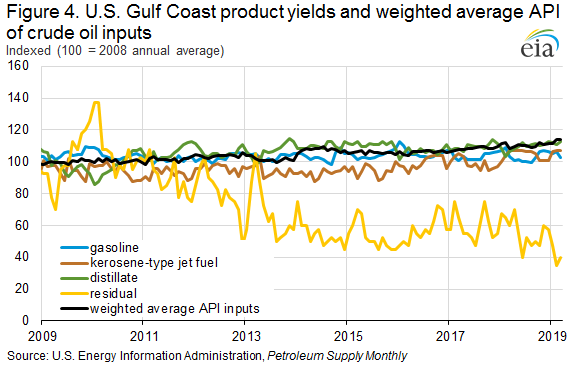
EIA’s Refinery Capacity Report – And Why It Matters
The EIA reported this week that 2019 refining capacity has set a new all-time high, meaning more fuel is being produced than ever before. In this case, increased capacity came not through new refineries but through expansion of a site in Texas. Relative to 2018, capacity rose 1.1% to 18.8 MMbpd, surpassing the previous record of 18.6 MMbpd set in 1981. Of course, refiners don’t run at 100% capacity all year long; in 2018 crude oil inputs averaged just 17.0 MMbpd (91.4% utilization).
Along with rising capacity has come an increasingly high quality crude input. WTI crude, known for its high API gravity (ie, lower density) and low sulfur content, has become popular with domestic refiners, and imports of heavier crudes have fallen. For that reason, outputs of refined products like gasoline and diesel have risen, while residuals (the heavy leftovers that typically go to asphalt or bunker fuel) have fallen sharply.
To put that decline in perspective, consider the approaching IMO deadline. Residuals are the low quality fuels currently being consumed by the maritime industry. Refiners seek to minimize this output because it trades so much more cheaply than gasoline or diesel. US refiners have the ability to fine tune their production to optimize for more or less residuals, giving them much more control to produce high quality fuel as IMO 2020 approaches. Other countries don’t have the high-tech systems needed to optimize residual output, meaning they will have to continue producing high-sulfur fuel oil to maintain their fuel outputs.
With more refining capacity and rising input, the US is expected to be a clear winner from IMO 2020. Our exports will be coveted worldwide, further propelling America towards being a net oil exporter. Unfortunately, domestic consumers may end up paying a premium to incentivize refiners to keep their fuel in the US. If prices rise too high, though, it’s possible the US could impose export restrictions to keep local prices low. It wouldn’t be unprecedented; crude exports were banned until just a few years ago. Fuel export restrictions are a longshot, but with a 2020 elections approaching, expect Washington to do what it can to keep fuel prices low.
This article is part of Crude
Tagged:
MARKET CONDITION REPORT - DISCLAIMER
The information contained herein is derived from sources believed to be reliable; however, this information is not guaranteed as to its accuracy or completeness. Furthermore, no responsibility is assumed for use of this material and no express or implied warranties or guarantees are made. This material and any view or comment expressed herein are provided for informational purposes only and should not be construed in any way as an inducement or recommendation to buy or sell products, commodity futures or options contracts.







